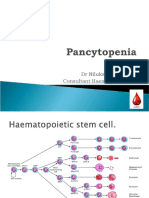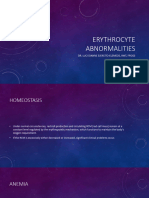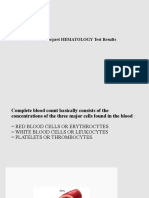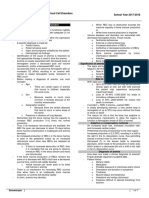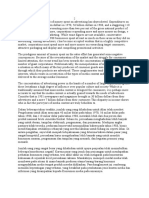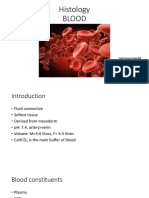ERYTHROCYTES
ERYTHROCYTES
Uploaded by
Philipp LibasoraCopyright:
Available Formats
ERYTHROCYTES
ERYTHROCYTES
Uploaded by
Philipp LibasoraCopyright
Available Formats
Share this document
Did you find this document useful?
Is this content inappropriate?
Copyright:
Available Formats
ERYTHROCYTES
ERYTHROCYTES
Uploaded by
Philipp LibasoraCopyright:
Available Formats
HOLY NAME UNIVERSITY – COLLEGE OF HEALTH SCIENCES
DEPARTMENT OF MEDICAL TECHNOLOGY
ERYTHROCYTES AND ABNORMALITIES
MT 114 LEC
________________________________________________________________________________
HOMEOSTASIS FOUR CATEGORIES OF ANEMIA:
- Under normal circumstances, red cell production and A. HYPOPROLIFERATIVE
circulating RCM (red cell mass) remain at a constant B. MATURATION DISORDERS
level regulated by the erythropoietic mechanism, C. HEMOLYTIC DISORDERS
which functions to maintain the body’s oxygen D. BLOODLOSS
requirement.
CLASSIFICATION OF ANEMIA
- If the RCM is excessively either decreased or
increased, significant clinical problems occur
1. Etiologic
ANEMIA 2. Morphologic
3. Physiologic
- Is the term used to denote conditions associated with
decrease red cells ANEMIA of BONE MARROW FAILURE:
- Best defined in reference to a decreased hemoglobin 1. Aplastic anemia
level, as the physiologic consequences and 2. Fanconi’s anemia
symptoms are the direct result of the decreased 3. Acquired Pure Red Cell Aplasia
oxygen-carrying capacity of the blood. 4. Diamond—Blackfan anemia
5. Myelopthisic anemia
ERYTHROCYTOSIS/POLYCYTHEMIA
ANEMIA of SYSTEMIC DISORDERS:
- Designate conditions involving the presence of too
many red cells in the circulation. • Anemia of chronic renal disease
• Anemia of endocrine disorders
- Best defined in relation to hematocrit level above the • Anemia of Pregnancy
established reference range.
APLASTIC ANEMIA
ABSOLUTE ANEMIA OR RELATIVE ANEMIA
- A condition in which there is a peripheral blood
Absolute anemia - there is true decrease in the RCM. pancytopenia, which is decreased in all cellular
constituents: leukocytes, erythrocytes, and
Relative anemia - this is secondary to the change in the platelets.
plasma volume, such that there is a shift of the
extravascular volume to the intravascular compartment, - The bone marrow is severely hypoplastic or aplastic.
expanding the plasma volume and diluting the RCM (e.g.
Pregnancy, hyperproteinemia) - There are no immature myeloid cells in the peripheral
blood.
ABSOLUTE/RELATIVE ERYTHROCYTOSIS
- There is absence of splenomegaly.
Absolute erythrocytosis - there is a true increase in the DIAGNOSTIC CRITERIA FOR SEVERE APLASTIC
RCM ANEMIA:
Relative erythrocytosis - there is decrease in the Bone marrow cellularity = < 25% of normal or <50% of
plasma volume, the RCM is normal (e.g. Dehydration) normal cellularity with <30% hematopoietic cells
LIBASORA, CHESKA THERESE 1
HOLY NAME UNIVERSITY – COLLEGE OF HEALTH SCIENCES
DEPARTMENT OF MEDICAL TECHNOLOGY
ERYTHROCYTES AND ABNORMALITIES
MT 114 LEC
________________________________________________________________________________
INHERITED PURE RED CELL ANEMIA
PLUS any two of the following:
Peripheral blood: Diamond Black-fan anemia (congenital hypoplastic
Granulocytes: <0.5 x 109/L anemia or PRCA)- a rare congenital disorder diagnosed
Platelets: <20 x 109/L during infancy or early childhood. -normocytic,
Anemia with < 1% reticulocytes normochromic anemia with normal leukocyte and platelet
counts and a marked decrease in marrow erythroblasts –
Primary Aplastic Anemia etiology
a. Congenital or Hereditary Fanconi’s anemia
b. Idiopathic Aplastic Anemia ACQUIRED PURE RED CELL
Secondary Aplastic Anemia
PRIMARY:
FANCONI’S ANEMIA - Idiopathic
- Immune mechanism
- A rare, inherited form of aplastic anemia, first seen in - Immunoglobulin Inhibitor to RBC precursors
3 brothers by Fanconi. - Erythropoietin inhibitor
- Autosomal recessive inheritance characterized as SECONDARY:
pancytopenia with hypoplastic to aplastic bone - Benign Thymomas
marrow. - Drugs
- Chemicals
Clinical presentation: microcephaly, brown skin - Infections
pigmentation, short stature, malformations of the - Hemolytic anemia-aplastic crises
thumbs, malformations of the kidney, genital
hypoplasia, internal strabismus and mental DIAMOND-BLACKFAN ANEMIA
retardation. CONGENITAL PURE RED CELL APLASIA
- A rare congenital disorder first described in 1938
HEMATOLOGIC PICTURE: manifests 5-10 years after
birth - A normochromic, normocytic anemia, normal
leukocyte count and platelet count, Marked decrease
- Anemia, neutropenia and thrombocytopenia in marrow erythroblasts
- Anisocytosis and poikilocytosis are seen - Diagnosed during infancy or early childhood
- Marked increase in hgb f, with resultant decrease in
Hgb A Etiology: unknown
- Osmotic fragility and esr are increased
- Pallor may be evident at birth and is almost always
Bone marrow- hypoplastic which eventually evident by 1 year of age
becomes aplastic
- Retarded growth, bone age retardation and failure of
TREATMENT: androgens to stimulate erythropoiesis and secondary sexual maturation, some have
corticosteroids : bone marrow transplantation osteoporosis
PURE RED CELL APLASIA - Characteristically, they do not demonstrate renal
Abnormalities
• Inherited
• Acquired LABORATORY FINDINGS:
- Primary Hb values as low as 1.7 g/dL to 9.4 g/dL normocytic,
- Secondary normochromic with normal red cell morphology, there is
poor response to erythropoietin, elevated Hgb
LIBASORA, CHESKA THERESE 2
HOLY NAME UNIVERSITY – COLLEGE OF HEALTH SCIENCES
DEPARTMENT OF MEDICAL TECHNOLOGY
ERYTHROCYTES AND ABNORMALITIES
MT 114 LEC
________________________________________________________________________________
• Treatment and prognosis will depend on the
PRINCIPAL CLINICAL AND LABORATORY underlying cause of the anemia
FACTORS
ANEMIA OF CHRONIC RENAL DISEASE
A hypoproliferative anemia that can be severe and almost
invariably occurs in patients with chronic renal failure; and
have elevated BUN levels.
The principal cause is the inadequate marrow response
to anemia because of decrease production of
erythropoietin; some studies have evidence that the bone
marrow may not respond to any form of erythropoietin
MANAGEMENT/TREATMENT:
- Patients have signs and symptoms of anemia,
depending on its severity.
- Red cell transfusions are the mainstays of therapy
every 3-6 weeks to prevent the symptoms of anemia
- Uremia or accumulation of waste products in the body
- after months to years of treatment, patients may
is associated with shortened red cell survival and
resultant mild hemolytic anemia
undergo remissions which may or may not be
maintained
- Normocytic, normochromic anemia (with normal
indices)
- 40-50% responds to steroid therapy
- bone marrow transplantation is also a potential
- Because of the resultant kidney disease, plasma
curative therapy
volume is increased, resulting in an artificially
decreased hematocrit.
MYELOPHTHISIC ANEMIA
• A common finding among 94% of cancer patients. - Although erythrocyte morphology is usually normal,
• Classified as hypoproliferative anemia, also the uremic condition occasionally produces abnormal
under anemia of chronic inflammation or chronic cells such as the BURR CELLS and some HELMET
disease. CELLS.
• In some PATIENTS, the degree of anemia
- There is a rough correlation between the degree of
correlates with the degree of tumor load. In
renal insufficiency (as measured by the serum
others, there is no correlation between the degree creatinine) and the hematocrit.
of anemia and the degree of tumor load.
• Results when the bone marrow is invaded by - The higher the serum creatinine, the lower the
abnormal cells or replacement by metastatic hematocrit and the more severe the anemia.
carcinoma, however there are cases where the
invasion is not due to metastatic cancer cells but - The degree of shortening of the red cell survival is
directly proportional to the creatinine level.
by other cells such as those with miliary
tuberculosis and granulomas.
o Dialysis therapy
• Not synonymous with o Successful kidney transplant
leucoerythroblastic reaction. o Recombinant human erythropoietin
• Leukoerythroblastic reaction - is the presence
of circulating nucleated RBC and immature
leukocytes in the peripheral blood.
• Diagnosis – thru bone marrow biopsy
LIBASORA, CHESKA THERESE 3
HOLY NAME UNIVERSITY – COLLEGE OF HEALTH SCIENCES
DEPARTMENT OF MEDICAL TECHNOLOGY
ERYTHROCYTES AND ABNORMALITIES
MT 114 LEC
________________________________________________________________________________
ANEMIA OF ENDOCRINE DISORDERS HEREDITARY ANEMIA OF INCREASED
DESTRUCTION
Anemia may develop secondary to interference with the
normal action of hormones on red cell production. • Hereditary Spherocytosis
• Hereditary Elliptocytosis
Red cells are normochromic, normocytic with the marrow • Hereditary Pyropoikilocytosis
showing only decreased erythroid production with normal • Hereditary Stomatocytosis/Hydrocytosis
myeloid and megakaryocyte production. • Pyruvate Kinase Deficiency Anemia
• Glucose-6-Phosphate Dehydrogenase Deficiency
o Hypothyroidism
Anemia
o Hypoadrenalism (Addison’s Disease)
• Abetalipoproteinemia
o Hypogonadism (testosterone-stimulates
renal erythropoietin production)
NON-IMMUNE HEMOLYTIC ANEMIA
ANEMIA OF PREGNANCY
- Microangiopathic Hemolytic anemia
- Thrombotic Thrombocytopenic purpura
There is expansion of the total blood volume which may
- Hemolytic Uremic Syndrome
be a physiologic protective mechanism against the effects
of excessive blood loss at the time of delivery. - Disseminated intravascular coagulation
ANEMIA OF MATURATION DISORDERS OTHERS:
- Hemolytic anemia associated with cardiovascular
MACROCYTIC DISORDERS prosthesis, aortic atenosis
1. Pernicious anemia - Hemolytic anemias associated with
2. Folate Deficiency anemia
3. Tropical Sprue/Non-Tropical Sprue parasites – malaria, toxoplamosis
4. Congenital Dyserythropoietic anemia bacteria – Clostridium, Staphylococcus,Streptococcus
- Animal bites
B. MICROCYTIC ANEMIA
1. Iron Deficiency anemia IMMUNE HEMOLYTIC ANEMIA
2. Anemia of Chronic Infectious, Non-Infectious and
Malignant Diseases
3. Sideroblastic anemia - Paroxysmal nocturna hemoglobinuria
4. Hereditary Hemochromatosis - Autoimmune hemolytic anemia-cold and warm types
- Paroxysmal cold hemoglobinuria
- Drug induced hemolytic anemia
E.g.
- Hemolytic disease of the newborn
• Alpha Thalassemia - Hemolytic transfusion reactions
• Beta Thalassemia
• Hereditary Persistence of Fetal Hemoglobin
• Hb-S Beta Thalassemia
• Sickle Cell anemia
LIBASORA, CHESKA THERESE 4
You might also like
- تجميع اسئله 2011Document35 pagesتجميع اسئله 2011walhali87% (39)
- Data Interpretation For Medical Students PDFDocument905 pagesData Interpretation For Medical Students PDFMar100% (1)
- DR Nilukshi Perera Consultant HaematologistDocument68 pagesDR Nilukshi Perera Consultant HaematologistThaveeshaLindsayWhiteNo ratings yet
- Hesi Practice QuestionsDocument31 pagesHesi Practice QuestionsEbookslatinosEbookslatinos75% (12)
- AnemiaDocument8 pagesAnemiasibanah menor100% (1)
- HEMADocument44 pagesHEMAJilycamae COSMODNo ratings yet
- Finals-Normocytic NotesDocument3 pagesFinals-Normocytic NotesAde LaiNo ratings yet
- HEMA1Document34 pagesHEMA1marie judimor gomezNo ratings yet
- Topic 6 - Anemia 1Document24 pagesTopic 6 - Anemia 1Vince Martin ManaigNo ratings yet
- AneamiaDocument41 pagesAneamiaVeena JomNo ratings yet
- Diseases of Hemopoietic SystemDocument29 pagesDiseases of Hemopoietic SystemRupak PandeyNo ratings yet
- (8-9) Hemolytic A.and AplasticDocument68 pages(8-9) Hemolytic A.and AplasticdfrdhpvbdxNo ratings yet
- M.03 Hemolytic AnemiaDocument5 pagesM.03 Hemolytic AnemiaRaymund AldabaNo ratings yet
- M6 Decreased RBC ProdnDocument3 pagesM6 Decreased RBC ProdnJan TrishaNo ratings yet
- Aplastic Hemolitic 2021 OlgaDocument43 pagesAplastic Hemolitic 2021 OlgalaibaNo ratings yet
- Hereditary Haemolytic Anaemia - Handout-By DR - Chandima Kulathilake-26th BatchDocument7 pagesHereditary Haemolytic Anaemia - Handout-By DR - Chandima Kulathilake-26th Batchchanakacb1No ratings yet
- Thalassaemia Hereditary Haem DisordersDocument12 pagesThalassaemia Hereditary Haem DisordersRawan HamzaNo ratings yet
- Anaemia: by Swaathi R Final Year MbbsDocument33 pagesAnaemia: by Swaathi R Final Year MbbsGopi Nath100% (1)
- 1621168808sampleDocument9 pages1621168808sampleSYED SHAZIYANo ratings yet
- Lecture 24-25 Intracorpuscular RBC DefectsDocument48 pagesLecture 24-25 Intracorpuscular RBC DefectsabooddahdouhNo ratings yet
- Chapter 3.3Document9 pagesChapter 3.3Ade LaiNo ratings yet
- Clinical Approach To Anemia: Fakultas Kedokteran Universitas Prima IndonesiaDocument24 pagesClinical Approach To Anemia: Fakultas Kedokteran Universitas Prima IndonesiaDzil FikriNo ratings yet
- Hemolytic AnemiaDocument99 pagesHemolytic AnemiaSagar Chandrakant Mhetre100% (3)
- Anemia HemolitikDocument37 pagesAnemia HemolitikBintang Ruth Cecilia FebrinaNo ratings yet
- Anaemia IntroductionDocument61 pagesAnaemia Introductionzarairahad486No ratings yet
- Approach To Hypocellular MarrowDocument74 pagesApproach To Hypocellular MarrowManasNo ratings yet
- Subject: Anemia - Defects of Red Blood Cell Membrane Production Discipline: PhysiopathologyDocument30 pagesSubject: Anemia - Defects of Red Blood Cell Membrane Production Discipline: PhysiopathologyCristina Teodora BerbecaruNo ratings yet
- K 15 - Haemolitic-AnemiaDocument28 pagesK 15 - Haemolitic-AnemiaAngel 冯晓君No ratings yet
- 5.1 PPT ANEMIADocument29 pages5.1 PPT ANEMIAResta SeptiaNo ratings yet
- Kelainan Darah 1 FKG 2020Document74 pagesKelainan Darah 1 FKG 2020Jeremy Kartika SoeryonoNo ratings yet
- Problems in Oxygenation Transport Med Surg TransesDocument6 pagesProblems in Oxygenation Transport Med Surg TransestrashhhtineNo ratings yet
- Anemia PediaDocument4 pagesAnemia PediatrialqwNo ratings yet
- Aplastic Anemia and Approach To Diagnosis in A Case of AnemiaDocument19 pagesAplastic Anemia and Approach To Diagnosis in A Case of Anemia2006suzainNo ratings yet
- How To Interpret HEMATOLOGY Test ResultsDocument36 pagesHow To Interpret HEMATOLOGY Test Resultssylvia haryantoNo ratings yet
- Hematologi Pada AnakDocument48 pagesHematologi Pada AnakRisma Orchita Agwisa FNo ratings yet
- Hematologi Pada Anak DR, Agus SpADocument48 pagesHematologi Pada Anak DR, Agus SpAZiyan BilqisNo ratings yet
- H 5. Hemolytic AnemiaDocument65 pagesH 5. Hemolytic Anemiachaitalinarwade10No ratings yet
- Erythrocyte Disorders HoDocument7 pagesErythrocyte Disorders HoyeldNo ratings yet
- AnaemiaDocument181 pagesAnaemiaShibili AbrahamNo ratings yet
- GMIA2Document44 pagesGMIA2Kirst KewinNo ratings yet
- AnaemiaDocument4 pagesAnaemiaRichardNo ratings yet
- Presentation 1Document73 pagesPresentation 1ابراهيم محمدNo ratings yet
- He MaDocument25 pagesHe MaBeep TerradoNo ratings yet
- Childhood Anaemia (Nutritional)Document66 pagesChildhood Anaemia (Nutritional)Emereole FrancesNo ratings yet
- Haemolytic Anaemia: DR Nurul Fahmiza Tumiran P109273Document55 pagesHaemolytic Anaemia: DR Nurul Fahmiza Tumiran P109273Nurul FahmizaNo ratings yet
- His127 Slide Haemolytic Anaemia PDFDocument69 pagesHis127 Slide Haemolytic Anaemia PDFclaudya zaraNo ratings yet
- Hemolytic AnemiaDocument81 pagesHemolytic AnemiaL3mi DNo ratings yet
- Acute Hemolytic AnemiaDocument2 pagesAcute Hemolytic AnemiaJocel CabayNo ratings yet
- Aplastic anemia presentationDocument23 pagesAplastic anemia presentationkhanfarhan.m.malik900No ratings yet
- AnaemiaDocument83 pagesAnaemiaMohammad_Islam87100% (2)
- Spleen Outline For FacultyDocument9 pagesSpleen Outline For Facultygaulep3164valNo ratings yet
- Anemia and Red Blood Cell Disorder Lecture by Dr. Rosales (Nov 6, 2017)Document7 pagesAnemia and Red Blood Cell Disorder Lecture by Dr. Rosales (Nov 6, 2017)Ian Gabrielle Mercado CuynoNo ratings yet
- Hemoglobinopati: Dr. Charles Antoni S.,M.Kes, Sp.ADocument26 pagesHemoglobinopati: Dr. Charles Antoni S.,M.Kes, Sp.AKaren PatriciaNo ratings yet
- Epidemiology:: in The Absence of Abnormal Infiltrate and With No Increase in ReticulinDocument6 pagesEpidemiology:: in The Absence of Abnormal Infiltrate and With No Increase in ReticulinSandeep m rNo ratings yet
- Lesson 7 - Hypoproliferative AnemiasDocument30 pagesLesson 7 - Hypoproliferative Anemiaskate.iral345No ratings yet
- Anemia Aplastik: Dr. Ariosta Setyadi Bagian Patologi Klinik Fakultas Kedokteran Universitas Diponegoro SemarangDocument15 pagesAnemia Aplastik: Dr. Ariosta Setyadi Bagian Patologi Klinik Fakultas Kedokteran Universitas Diponegoro SemarangRamdani GansNo ratings yet
- Patho FinaaaaalllDocument15 pagesPatho FinaaaaalllIvin SajithNo ratings yet
- AnemiaDocument11 pagesAnemiaNada AmjadNo ratings yet
- Patho HematologyDocument39 pagesPatho HematologyCastleKGNo ratings yet
- Haemolytic Anaemias: PathologyDocument18 pagesHaemolytic Anaemias: Pathologywael rizkNo ratings yet
- Anemia 2011 Student Dental FDocument64 pagesAnemia 2011 Student Dental Fkays30002403No ratings yet
- BMLT Class Note On Anemia ClassificationDocument2 pagesBMLT Class Note On Anemia ClassificationSubhasish BarikNo ratings yet
- Philipp Chester LIBASORA - 2Q L2 Learning Exercise 1Document2 pagesPhilipp Chester LIBASORA - 2Q L2 Learning Exercise 1Philipp LibasoraNo ratings yet
- PMLS FinalsDocument20 pagesPMLS FinalsPhilipp LibasoraNo ratings yet
- Indicators APA MLA CSW: AlignmentDocument5 pagesIndicators APA MLA CSW: AlignmentPhilipp LibasoraNo ratings yet
- 2Q L4 Brainstorming 1Document2 pages2Q L4 Brainstorming 1Philipp LibasoraNo ratings yet
- PMLS 1Document4 pagesPMLS 1Philipp LibasoraNo ratings yet
- Gen - Chemistry PosterDocument1 pageGen - Chemistry PosterPhilipp LibasoraNo ratings yet
- Anatomy and Physiology: Definition of TermsDocument11 pagesAnatomy and Physiology: Definition of TermsPhilipp LibasoraNo ratings yet
- Full Download Essentials of Clinical Pathology 2nd Edition Shirish M. Kawthalkar PDF DOCXDocument82 pagesFull Download Essentials of Clinical Pathology 2nd Edition Shirish M. Kawthalkar PDF DOCXlinydoshka100% (5)
- BloodDocument134 pagesBloodjajahsalma8No ratings yet
- Human Body - A Visual Encyclopedia (PDFDrive) - 69-71Document3 pagesHuman Body - A Visual Encyclopedia (PDFDrive) - 69-71Neeha NMNo ratings yet
- Pemeriksaan DarahDocument11 pagesPemeriksaan DarahJems BoruNo ratings yet
- Target Paper - Xi Zoology by Sir MuneebDocument3 pagesTarget Paper - Xi Zoology by Sir MuneebmahmadwasiNo ratings yet
- The Use of Hematocrit Centrifuge by Using A Blood Sample of S.TR Medical Laboratory Technology StudentsDocument12 pagesThe Use of Hematocrit Centrifuge by Using A Blood Sample of S.TR Medical Laboratory Technology StudentsAnisa IstiqomahNo ratings yet
- Blood Test and Normal RangeDocument40 pagesBlood Test and Normal Rangeethirukumaran50% (2)
- Human Body - 1Document9 pagesHuman Body - 1gemini_157No ratings yet
- Column Agglutination Technology: The Antiglobulin Test: Agglutination of Red CellsDocument5 pagesColumn Agglutination Technology: The Antiglobulin Test: Agglutination of Red CellsOB3 Ortho Clinical DiagnosticsNo ratings yet
- CP Practicals 1Document63 pagesCP Practicals 1Liana Ysabelle CasusiNo ratings yet
- Multiple Myloma AneamiaDocument3 pagesMultiple Myloma AneamiaShafiq Ahmad KhanNo ratings yet
- P2W3 Introduction To Increased Destruction of ErythrocytesDocument16 pagesP2W3 Introduction To Increased Destruction of ErythrocytesAyessa VillacorteNo ratings yet
- Health in A Natural WayDocument160 pagesHealth in A Natural Wayapi-27242818100% (1)
- Argumentative EssayDocument24 pagesArgumentative EssayLiu166No ratings yet
- Bahasa EnggressssDocument10 pagesBahasa EnggresssshanifkhoirudinNo ratings yet
- Nursing Clients With Hematologic DisordersDocument4 pagesNursing Clients With Hematologic DisordersLuna MarieNo ratings yet
- Nsejs Exam Solutions Paper 2019 PDFDocument27 pagesNsejs Exam Solutions Paper 2019 PDFMrinalini SinghNo ratings yet
- Anemia Overview: The Third Hospital of Sun Yat-Sen UniversityDocument77 pagesAnemia Overview: The Third Hospital of Sun Yat-Sen UniversityMazlina MaidinNo ratings yet
- Hema Poikilocytosis StatPearls NCBI BookshelfDocument10 pagesHema Poikilocytosis StatPearls NCBI BookshelfVincent ReyesNo ratings yet
- Gebre TekluDocument78 pagesGebre Tekludon yenNo ratings yet
- Immuno Hema - EX 2 ACT - Veloso, Mary Raffaele G - BSMT 3DDocument3 pagesImmuno Hema - EX 2 ACT - Veloso, Mary Raffaele G - BSMT 3DAnneNo ratings yet
- Academic Progress in Biology Grade 9Document148 pagesAcademic Progress in Biology Grade 9Aisha Coowar DurbassNo ratings yet
- Human Physiology (1) : Prepared & PresentedDocument47 pagesHuman Physiology (1) : Prepared & Presentedaliahmed12wNo ratings yet
- POLYCYTHEMIADocument48 pagesPOLYCYTHEMIAPoova RagavanNo ratings yet
- BLOOD COMPOSITION - Google FormsDocument3 pagesBLOOD COMPOSITION - Google FormsRonald Deck YamiNo ratings yet
- Histology Blood: Sujit Kumar Mandal NaihsDocument30 pagesHistology Blood: Sujit Kumar Mandal NaihsSujit MandalNo ratings yet
- Human Genetic Disorders - 2022Document22 pagesHuman Genetic Disorders - 2022dr_47839666No ratings yet


